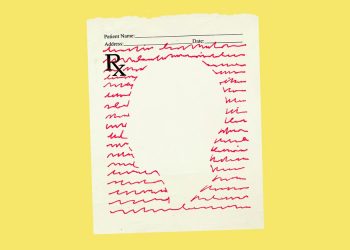For as long as my marriage lasts, my household will be divided by reactions to vaccines.
I am, fortunately, speaking of physical reactions rather than ideological ones; my partner and I are both shot enthusiasts, a fact we verified on our first date. But if my immune system is a bashful wallflower, rarely triggering more than a sore arm in the hours after I get a vaccine, then my spouse’s is a party animal. Every immunization I’ve watched him receive—among them, four doses of Moderna’s COVID-19 vaccine—has absolutely clobbered him with fevers, chills, fatigue, and headaches for about a full day. When he got the flu shot and the bivalent COVID jab together a few weeks ago, he ended up taking his first day off work in more than a decade. As usual, the same injections caused me so few symptoms that I wondered if I was truly dead inside.
“Why don’t you feel anything?” my spouse howled at me from the bedroom, where his sweat was soaking through the sheets. “Sorry,” I yelled back from the kitchen, where I was prepping four days’ worth of meals between work calls after returning from an eight-mile run.
If this is how every autumn will go from now on, so be it: A few hours of discomfort is still worth the rev-up in defenses that vaccines offer against serious disease and death. But it’s not hard to see that gnarly side effects will only add to the many other factors that work against COVID-vaccine uptake, including lack of awareness, sloppy messaging, dwindling access, and spotty community outreach. Back in the spring, when I spoke with several people who hadn’t gotten boosters despite being eligible for many, many months, several of them cited the post-shot discomfort as a reason. Now I’m getting texts and calls from family members and friends—all up to date on their previous COVID vaccines—admitting they’ve been dillydallying on the bivalent to avoid those symptoms too. “I don’t know if we’re going to continue to get strong buy-in from the public if they have this sort of reaction every year,” says Cindy Leifer, an immunologist at Cornell University.
The good news, at least, is that experts told me they don’t expect this bivalent recipe—or future autumn COVID shots, for that matter—to be worse, side-effect-wise, than the ones we’ve received before. It’ll take a while for data to confirm that, especially considering that more than a month into this fall’s rollout, fewer than 15 million Americans have received the updated shot. But Kathleen Neuzil, a vaccinologist at the University of Maryland School of Medicine who has studied the performance of COVID vaccines in clinical trials, pointed out to me that the mRNA shots’ ingredients have been swapped out before without altering the rate of side effects. As the alphabet soup of variants began to sweep the world in early 2021, she told me, vaccine makers started to tinker with alternate formulations, sometimes combining multiple versions of the spike protein into a single shot—“and they’re all comparable.” (If anything, early data suggest that bivalent shots containing an Omicron variant spike may be easier to take.) The same goes for flu vaccines, which are also retooled each year: When measured across the population, the frequency and intensity of side effects remain more or less the same.
On average, then, mRNA-vaxxed people can probably expect to have an annual experience that’s pretty similar to the one they had with their first COVID booster. As studies have shown, that one was actually better for most people than dose No. 2, the most unpleasant of the injections so far. (The math, of course, becomes tougher for people getting another vaccine, such as the flu shot, at the same time.) There are probably two main reasons why side effects have lessened overall, experts told me. First, the spacing: Most people received the second dose in their Pfizer or Moderna primary series just three or four weeks after the first. That’s an efficient way to get a lot of people “fully vaccinated” in a short period of time, but it means that many of the immune system’s defensive cells and molecules will still be on high alert. The second shot could end up fanning a blaze of inflammation that was never quite put out. In line with that, researchers have found that spacing out the primary-series doses to eight weeks, 12 weeks, or even longer can prune some side effects.
Dose matters a lot too: Vaccines are, in a way, stimulants meant to goad the immune system into reacting; bigger servings should induce bigger jolts. When vaccine makers were tinkering with their recipes in early trials, higher doses—including ones that were deemed too large for further testing—produced more side effects. Each injection in Moderna’s primary series contains more than three times the mRNA packaged into Pfizer’s, and Moderna has, on average, caused more intense side effects. But Moderna’s booster and bivalent doses contain a smaller scoop of the stimulating material: People 12 and older, for instance, get 50 micrograms instead of the 100 micrograms in each primary dose; kids 6 to 11 years old get 25 micrograms instead of 50. (All of Pfizer’s doses stay the same size across primaries and boosters, as long as people stay in the same age group.) People who switch between brands, then, may also notice a difference in symptoms.
It’s a tricky balance, though. Sometimes, the immune system adjusts the magnitude of its protection to match the danger posed by a pathogen (or shot), a bit like titrating a crisis response to the severity of a threat—so it’s important that vaccine makers don’t undershoot. For better or worse, the mRNA-based COVID vaccines do seem to cause a rougher response than most other vaccines, including annual flu shots. One of the offending ingredients might be the mRNA itself, which codes for SARS-CoV-2’s spike protein. But Michela Locci, an immunologist at the University of Pennsylvania, told me that the mRNA’s packaging—a greasy fat bubble called a lipid nanoparticle—may be the more likely culprit. For some people, in any case, the side effects of COVID shots might be on par with those of the two-dose Shingrix vaccine, one of the most infamously reactogenic immunizations in our roster. Leifer, who has received both, told me the second dose of each “floored” her to about the same extent.
The fact that I get fewer side effects than my spouse does not imply that I’m any less protected. A ton of factors—genetics, hormone levels, age, diet, sleep, stress, pain tolerance, and more—could potentially influence how someone experiences a shot. Women tend to have more reactive bodies, as do younger people. But there are exceptions to those trends: I’m one of them. The whole topic is understudied, Locci told me. Her own recent experience with the bivalent threw her for a loop. After her first, second, and third dose of Moderna each ratcheted up in side-effect severity, she cleared her calendar for the couple of days following her bivalent, “afraid I was going to be in bed with a fever again,” she said: “But it was a light headache for a morning, and then it was over.” She has no idea what next year will bring.
Either way, side effects such as fevers and chills tend to be short-lived. “Very few side effects are severe,” Neuzil told me, “and COVID continues to be a severe disease.” Still, Grace Lee, a pediatrician at Stanford and the chair of the CDC’s Advisory Committee on Immunization Practices, hopes that scientists will keep developing new COVID vaccines that might come with fewer post-shot issues—including the very rare ones, such as myocarditis—without sacrificing immune protection. Lee doesn’t tend to react much to vaccines, but her daughter “always misses school the next day,” she told me. “I plan her shots for a Friday afternoon so she can lay out all Saturday.” Early on, when hardly anyone had immunity to the virus, signing everyone up for somewhat reactogenic shots was a no-brainer—especially given the hope that two doses would yield many, many years of protection. Now that we know it’s a repeated need, Neuzil said, “the equation changes a bit.”
People aren’t totally helpless against side effects. Deepta Bhattacharya, an immunologist at the University of Arizona, had an “awful, terrible” experience with his second and third doses, which slammed him with 102- and 103-degree fevers, respectively. He weathered the side effects without intervention, worried that a painkiller would curb not just the agony, but also his protective immune response. This time, though, armed with new knowledge from his own lab that anti-inflammatory and pain-relieving drugs don’t blunt antibody levels, “the first sign I feel even the slightest bit shitty,” he told me, “I’m dosing up.”
I’ll probably do the same for my spouse the next time he’s due for a vaccine of any kind … likely while I chill on the sidelines. Bhattacharya’s spouse, too, is kind of an immune introvert, a fact that he bemoans. “Her only side effect was she felt thirsty,” he said. “It’s just not fair.”
Source by www.theatlantic.com











